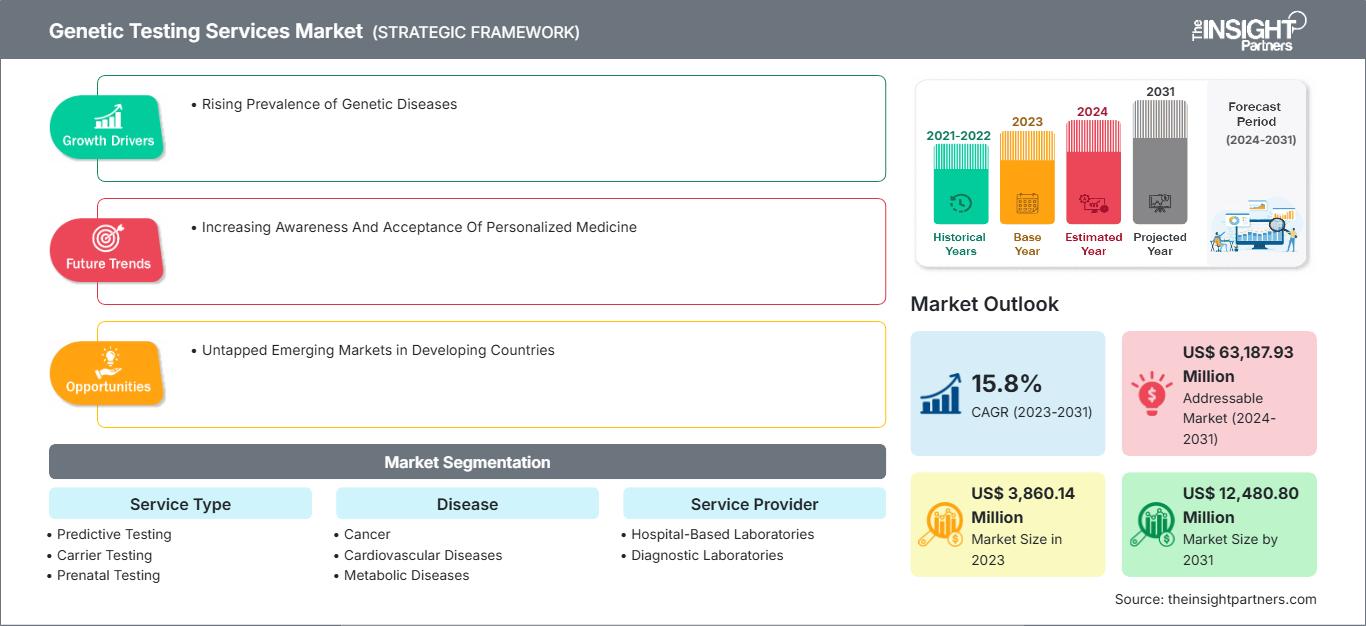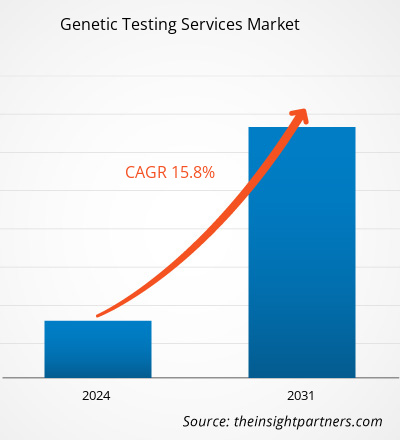The genetic testing services market size is projected to reach US$ 12,480.80 million by 2031 from US$ 3,860.14 million in 2023. The market is expected to register a CAGR of 15.8% during 2023–2031. Artificial intelligence-powered genetic testing is likely to bring new trends in the genetic testing services market in the coming years.
Genetic Testing Services Market Analysis
The factors driving the genetic testing services market include the introduction of reimbursement programs, growing demand for efficient treatment choices, and implementation of innovative technologies in research centers. Growing awareness of the advantages of genetic testing and the increase in consumer spending on healthcare are boosting the growth of the genetic testing services market. Increasing demand for genetic testing to diagnose chronic conditions has supported players in investing in the development of new services and expansion strategies. Moreover, the increase in the incidence of genetic disorders and cancer plays a vital role in the development of the genetic testing industry.
Genetic Testing Services Market Overview
Genetic testing is a medical and scientific procedure that involves the examination and analysis of a person's DNA to understand their genetic makeup and genetic information. The genetic testing services market in the UK is anticipated to grow substantially due to a rise in the prevalence of genetic disorders and cancer. For instance, as per Genetic Alliance UK 2021, rare diseases affect 3.5 million people in the country; that is 1 in 17 people. As per Gene People UK 2023, it is estimated that 1 in 25 children suffer from a genetic disorder, meaning that 30,000 babies and children are newly diagnosed yearly in the UK, and over 2.4 million children and adults are suffering from a genetic disorder.
In Germany, noninvasive prenatal testing became available as a publicly reimbursed test in 2022. In addition, significant advances are being made in genomics, paving the way for enhanced access to personalized medicine. The UK established the infrastructure to support greater access to genomic testing, including a national network of genomic laboratories and Genomic Medicine Centers that provide clinical services. In 2019, the government announced Early Disease Detection Research Project UK, which is a significant new initiative that focuses on the major chronic diseases of adult life, including all cancers, cardiovascular disease, and other such diseases.
Customize This Report To Suit Your Requirement
You will get customization on any report - free of charge - including parts of this report, or country-level analysis, Excel Data pack, as well as avail great offers and discounts for start-ups & universities
Genetic Testing Services Market: Strategic Insights

-
Get Top Key Market Trends of this report.This FREE sample will include data analysis, ranging from market trends to estimates and forecasts.
Genetic Testing Services Market Drivers and Opportunities
Rising Prevalence of Genetic Diseases Favors Market Growth
The prevalence of genetic diseases is rising across the world and impacting the health of people at a severe level. Genetic diseases show many symptoms that are uncommon and are mostly non-curable. According to The World Health Organization (WHO) 2021, 10 out of every 1,000 people are affected by single-gene diseases, signifying that 70 million and 80 million people worldwide are living with any one service type of single-gene disease. As per the Global Genes, ~7,000 known rare diseases and disorders have been identified worldwide, and more are being discovered every year. In 2022, a report by MJH Life Sciences (US) estimated that 300,000 newborns worldwide are born with sickle cell disease every year, accounting for ∼5% of the global population. In June 2020, as per Novartis AG (Switzerland) report, ∼15,000 individuals were suffering from sickle cell disease in the UK, and 270 newborns are diagnosed with the condition every year. Thus, the rising prevalence of genetic diseases fuels the demand for genetic testing, which in turn drives genetic testing services market growth.
Untapped Emerging Markets in Developing Countries
Emerging countries such as China, India, Brazil, and Mexico offer significant growth opportunities to market players. The quality and availability of genetic services may differ between high-income countries and low- to middle-income countries. For instance, in the US, Australia, Canada, the UK, and other European countries, genetic services are well-advanced, established, and extensive. These services include newborn screening, carrier identification screening, and prenatal diagnosis. Yet, in many high-income countries, genetic services that are offered in multiple settings still need improved systems of assessment. Major market players are focusing on strategies and initiatives, such as agreements, collaborations, partnerships, and expansions, to improve their product availability, accessibility, and distribution networks in these countries, as it will help them address the growing need for early diagnosis and treatment.
The Chinese government identifies genomics as an important strategic field in its 14th Five-Year Plan (2016–2020) for the country's economic and social development. In 2016, the Chinese Academy of Sciences launched the Precision Medicine Initiative, a 14-year project worth US$ 9.2 billion to sequence more than 100 million human genomes by 2030. In December 2017, China's Ministry of Science and Technology collaborated with a human genome research project to document the genetic makeup of 100,000 people. Employing the genetic data of nine different minority groups, researchers desire to decode hereditary information within genes. Therefore, emerging markets in developing countries are expected to offer lucrative opportunities for the growth of the genetic testing services market during the forecast period.
Genetic Testing Services Market Report Segmentation Analysis
Key segments that contributed to the derivation of the genetic testing services market analysis are service type, disease, and service provider.
- Based on service type, the genetic testing services market is categorized into predictive testing, carrier testing, prenatal testing, newborn screening, diagnostic genetic testing, and others. The predictive testing segment held the largest share of the market in 2023 and is expected to register the highest CAGR in the market during 2023–2031.
- By disease, the genetic testing services market is segmented into cancer, cardiovascular diseases, metabolic diseases, and other diseases. The cancer segment held the largest share of the market in 2023 and is projected to register the highest CAGR in the market during 2023–2031.
- In terms of service provider, the genetic testing services market is segmented into hospital-based laboratories, diagnostic laboratories, and others. The hospital-based laboratories segment held the largest share of the market in 2023 and is anticipated to register the highest CAGR in the market during 2023–2031.
Genetic Testing Services Market Share Analysis by Geography
The geographic scope of the genetic testing services market report is mainly divided into five regions: North America, Asia Pacific, Europe, Middle East & Africa, and South & Central America. North America held a significant share of the market in 2023. The growth of the market is driven by rising number of cancer patients, increasing government funding, and rising incidence of genetic diseases among the population in the US and Canada during recent years. As per the estimates of the US Government Accountability Office published in October 2021, ~25 to 30 million people suffer from rare diseases in the country; nearly 50% of patients with rare diseases are children. Rare diseases are often the result of a genetic mutation; it is estimated that 80% of rare diseases are genetic.
In addition, increasing focus on advanced method incorporation in healthcare, government, and private initiatives for the promotion of precision medicine, and massive funds from government and private bodies for genetic research are projected to accelerate the growth of the genetic testing services market in the region.
Genetic Testing Services Market Regional Insights
The regional trends and factors influencing the Genetic Testing Services Market throughout the forecast period have been thoroughly explained by the analysts at The Insight Partners. This section also discusses Genetic Testing Services Market segments and geography across North America, Europe, Asia Pacific, Middle East and Africa, and South and Central America.
Genetic Testing Services Market Report Scope
| Report Attribute | Details |
|---|---|
| Market size in 2023 | US$ 3,860.14 Million |
| Market Size by 2031 | US$ 12,480.80 Million |
| Global CAGR (2023 - 2031) | 15.8% |
| Historical Data | 2021-2022 |
| Forecast period | 2024-2031 |
| Segments Covered |
By Service Type
|
| Regions and Countries Covered |
North America
|
| Market leaders and key company profiles |
|
Genetic Testing Services Market Players Density: Understanding Its Impact on Business Dynamics
The Genetic Testing Services Market is growing rapidly, driven by increasing end-user demand due to factors such as evolving consumer preferences, technological advancements, and greater awareness of the product's benefits. As demand rises, businesses are expanding their offerings, innovating to meet consumer needs, and capitalizing on emerging trends, which further fuels market growth.

- Get the Genetic Testing Services Market top key players overview
Genetic Testing Services Market News and Recent Developments
The genetic testing services market is evaluated by gathering qualitative and quantitative data post primary and secondary research, which includes important corporate publications, association data, and databases. A few of the developments in the genetic testing services market are listed below:
- GeneDx enhanced its whole genome sequencing (WGS) offering, aiming to accelerate diagnoses and shorten the diagnostic odyssey for patients. These new features include faster turnaround time for rapid whole genome sequencing (rWGS), buccal samples, and repeat expansions. Combined with its industry-leading dataset and product enhancements, GeneDx improved the accessibility and effectiveness of whole genome sequencing for diagnostic purposes – eventually working to stop or reduce the progression of both common and rare diseases. (Source: GeneDx, Press Release, July 2024)
- Progenesis, a renowned global genetic testing brand headquartered in the US, entered the Indian market with the inauguration of its first Genetic Laboratory in New Delhi and an artificial intelligence (AI) & Bioinformatics Data Centre in Chennai. The brand collaborates with local healthcare providers, fertility clinics, and medical practitioners to expand its footprint and make advanced genetic testing solutions more accessible to a wider audience. (Source: Progenesis, Press Release, December 2023)
Genetic Testing Services Market Report Coverage and Deliverables
The “Genetic Testing Services Market Size and Forecast (2021–2031)” report provides a detailed analysis of the market covering below areas:
- Genetic testing services market size and forecast at global, regional, and country levels for all the key market segments covered under the scope
- Genetic testing services market trends as well as market dynamics such as drivers, restraints, and key opportunities
- Detailed PEST and SWOT analysis
- Genetic testing services market analysis covering key market trends, global and regional framework, major players, regulations, and recent market developments
- Industry landscape and competition analysis covering market concentration, heat map analysis, prominent players, and recent developments for the genetic testing services market
- Detailed company profiles
Frequently Asked Questions
What are the driving factors impacting the genetic testing services market?
Which are the leading players operating in the genetic testing services market?
What is the expected CAGR of the genetic testing services market?
Which region dominated the genetic testing services market in 2023?
What would be the estimated value of the genetic testing services market by 2031?
- Historical Analysis (2 Years), Base Year, Forecast (7 Years) with CAGR
- PEST and SWOT Analysis
- Market Size Value / Volume - Global, Regional, Country
- Industry and Competitive Landscape
- Excel Dataset
Recent Reports
Related Reports
Testimonials
Reason to Buy
- Informed Decision-Making
- Understanding Market Dynamics
- Competitive Analysis
- Identifying Emerging Markets
- Customer Insights
- Market Forecasts
- Risk Mitigation
- Boosting Operational Efficiency
- Strategic Planning
- Investment Justification
- Tracking Industry Innovations
- Aligning with Regulatory Trends





















 Get Free Sample For
Get Free Sample For